The Arizona-Sonora Desert Museum’s Haag Cactus Garden Celebrates its 50 Years With a New Look
From Desert Breeze
Newsletter of the Tucson Cactus and Succulent Society
Published: 05/5/2016
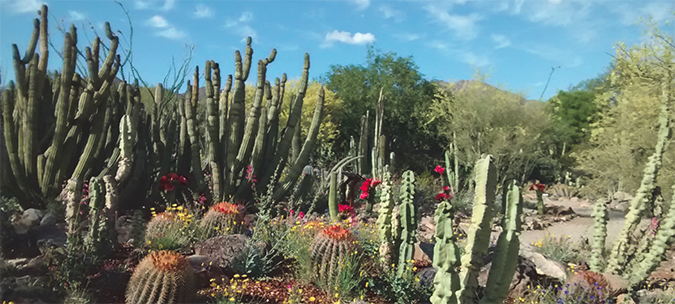
The Haag Cactus Garden is home to 138 species of cacti - Credit Nancy Serensky
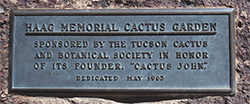
A plaque dedicated to founder Cactus John Haag. Credit M Paganelli
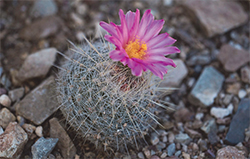
The Chihuahuan snowball (Thelocactus macdowellii) is just one of many cacti
in the garden-credit Liz Kemp
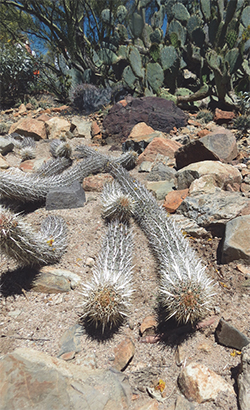
A stream of Creeping Devils (Stentocererus eruca) enhance a dry wash - credit M. Paganelli

A strawberry pot with red and yellow barrels is a garden feature. Credit Jason Wiley

Vibrant Flying Saucers (Trichocereus Hybrid) lend color to the landscape - credit Jason Wiley
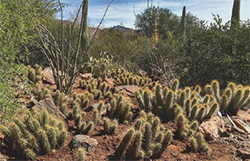
Nichols Golden Hedgehogs Rescued from Silverbell Mine now have a new home - Credit Jason Wiley

Wildflowers are interspersed with endangered Echinocactus horizonthalonius nicholii - Credit Jason Wiley

Eye catching CoreTen oxidized metal planters at the entrance to the Garden - credit Jason Wiley
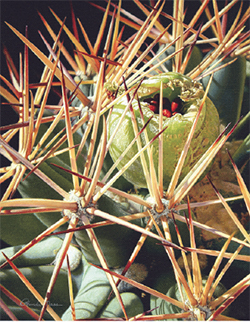
The endangered Pima Pineapple Cactus - credit Rhonda Nass
Dedicated in May 1965, this unique garden is named in honor of “Cactus” John Haag, founder of the Tucson Cactus & Succulent Society and curator of plants at the Arizona-Sonora Desert Museum from 1957-1959.
Home to 138 species of cacti, including some of Mr. Haag’s personal collection and several rare and endangered species, the garden was created to help educate people about cacti and other succulent plants of the Sonoran Desert Region. Celebrating its 50th birthday, the garden has undergone some wonderful enhancements under the leadership of Arizona- Sonora Desert Museum Horticulturist Jason Wiley.
Working with a number of volunteers, Wiley has spent the past two years completely reworking the garden, with an all-new look and a broader array of species. “We’ve been working very hard on getting the Cactus Garden looking more dramatic, inspiring and manicured,” says Wiley.
Three architectural oxidized metal planters at the entrance are just one of the enhancements to the Garden. These dramatic and sculptural planters clearly delineate the garden’s entrance, welcoming guests and providing a visual contrast to the soft colors and contours of the vegetation.
Since May of 2014, over a thousand new specimens have been added to the garden –an increase of more than 40 percent. Some of these new additions include several visually stunning “Flying Saucer” (Trichocereus hybrid) Torch Cacti, which add drama and beauty to the Garden. These cacti have been cleverly placed so that they are highly visible from the entrance, but far enough back into the Garden so that guests are drawn in to get a closer look at the breathtaking blooms. Other additions include barrels, hedgehogs, Thelocactus, and several unusual forms of Senita: a “Wooly Rhino” whose blond bristles go all the way to the ground; and “Jim’s Giant,” which has enormously fat arms. Wiley has also planted numerous golden hedgehogs rescued from the Silver Bell Mine where a leach fi eld is being installed. The garden is also home to the Pima Pineapple Cactus (Coryphantha robustispina), and Echinocactus horizonthalonius nicholii, two of the Sonoran Desert’s endangered species.
Another aesthetic addition is a “river” of Creeping Devil (Stenocereus eruca) that will flow through the Garden. The display created by these dramatic, ground-hugging cacti provides some visual continuity running throughout the garden, showcasing these rare examples of desert flora. Since the “river” is still a work in progress, Wiley is seeking donations of cuttings or specimens of this unique southwest succulent.
Also contributing to the Garden’s aesthetics is what you don’t see: the popup sprinklers that dotted the area. In a continuing process, much of the garden was converted to drip irrigation, which not only eliminated the old popups but also improved the effi ciency of the watering system. This style of irrigation dramatically increases the depth into the soil that can be watered without it running off , and prevents any minerals from depositing onto the specimens over time and making them appear dull.
Other subtle changes include the addition of soil in the barrel cactus area (8 yards of Native Plant Mix) that increases the height of the barrel mounds by 12-24 inches in diff erent areas.
This makes the topography much more interesting and also improves the soil for the growth of the new specimens. Several areas have also been topdressed with new rock and local pecan shells for a fi nished manicured look. Both of these added materials will also help with any evaporation from the ground and erosion. The pecan shells around non-Tucson native cacti will provide relief from the heat and keep surface light from sunburning the plants.
These exciting developments have resulted in a 320% increase in Garden visitation, with guests spending much more time walking the paths, exploring and learning.
Future plans for the Garden include adding more mass plantings of cacti, contouring the topography, adding architectural elements, and educating guests through additional signage. Wiley’s personal goal is “to inspire people to plant dramatic and sustainable succulent gardens while also adding habitat for both humans and wildlife to live together, with an emphasis on regionally appropriate plants.”
No doubt Mr. Haag would be proud of his namesake garden today as the Desert Museum continues to build upon his vision. The 1965 Cactus Chatter Bulletin predicted “John’s garden will be a source of lasting pleasure and education to generations of visitors.” This year a number of supporters have contributed to making these exciting Garden renovations possible. With ongoing support, the Garden will continue to blossom and grow for the next 50 years.
(For more information, please contact Cree Zischke, Arizona-Sonora Desert Museum Director of Philanthropy, 520-883-3039, czischke@desertmuseum.org)










